
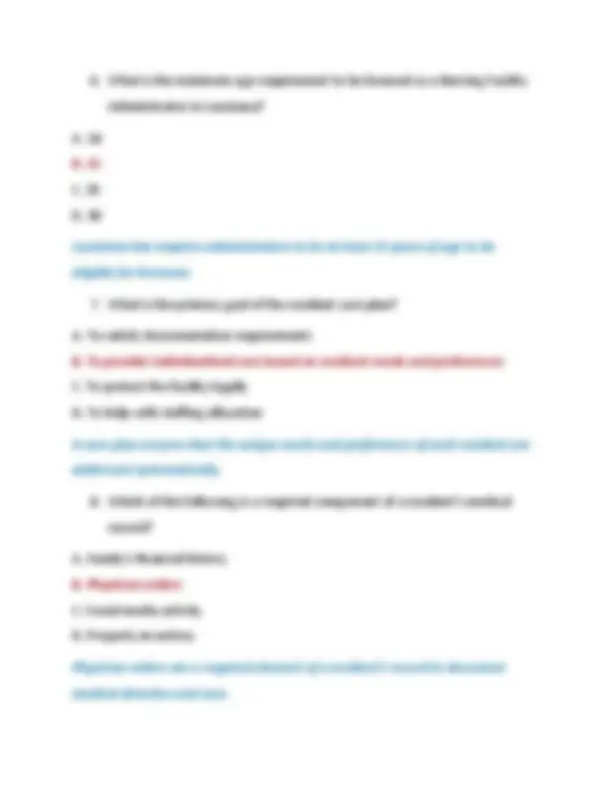
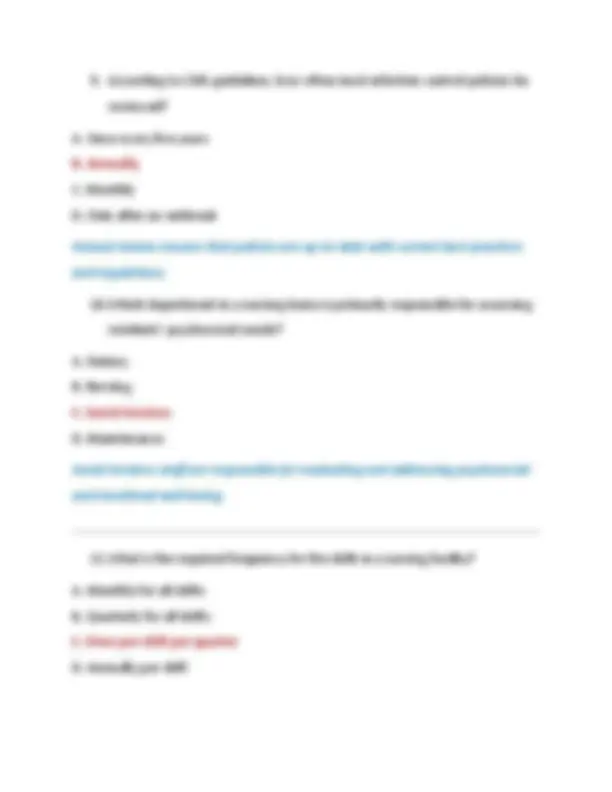
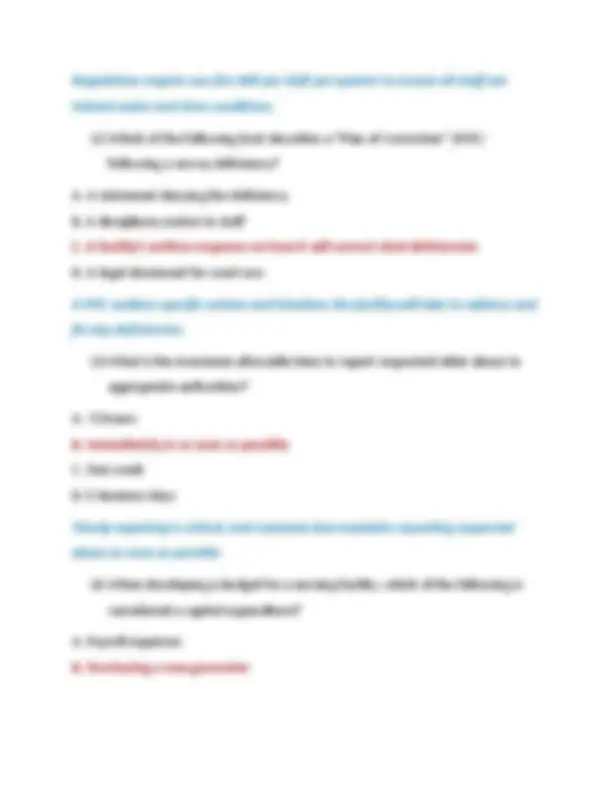
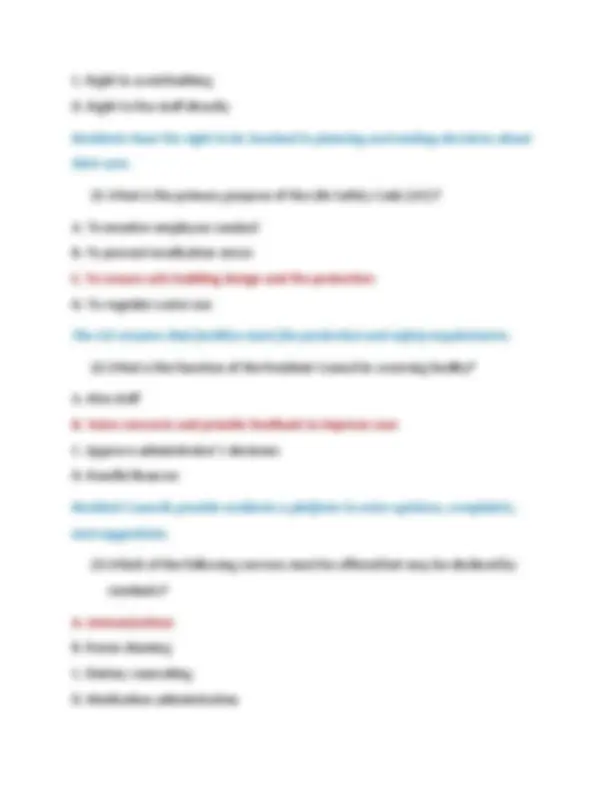
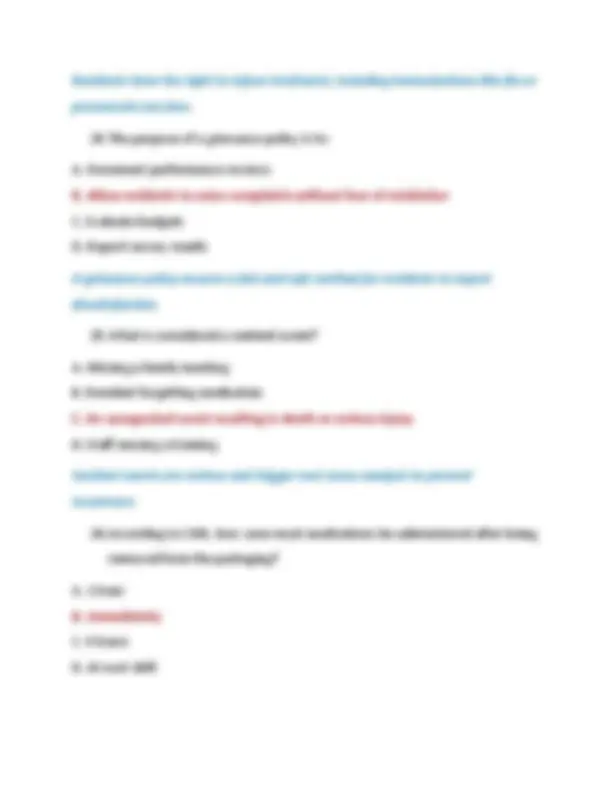
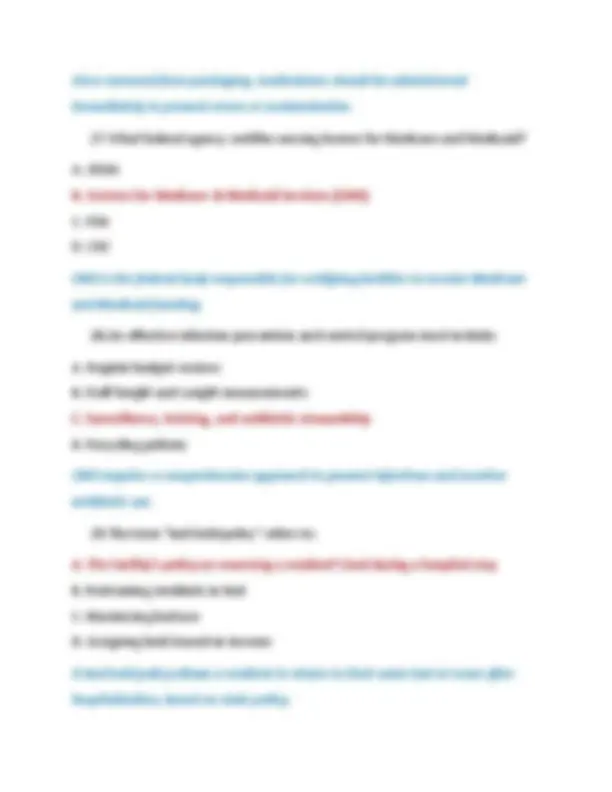
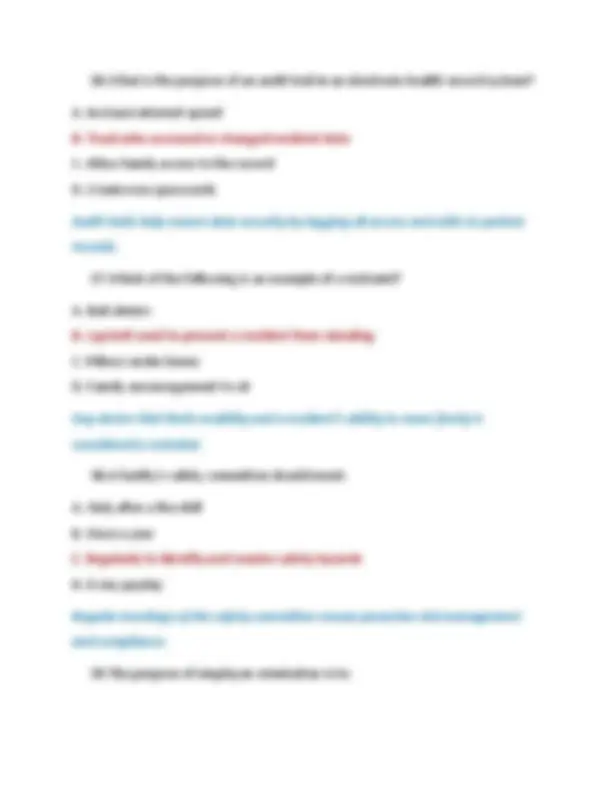

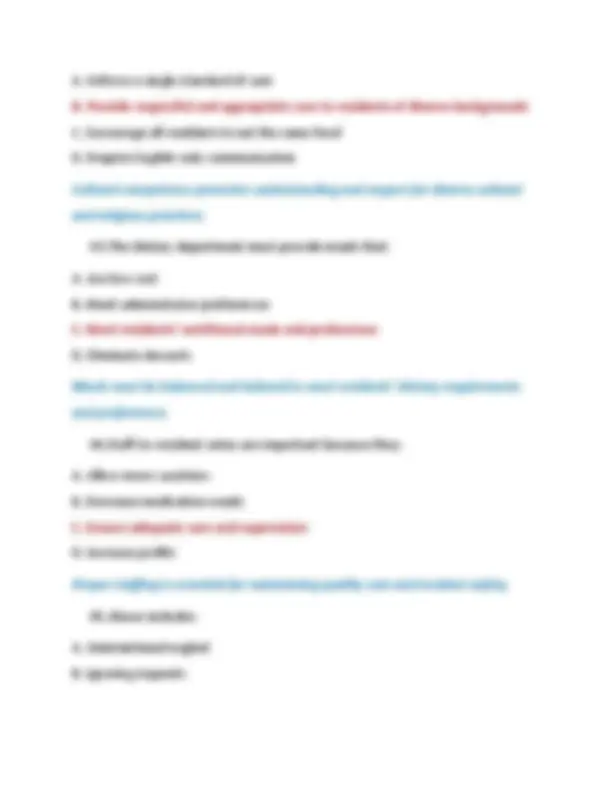
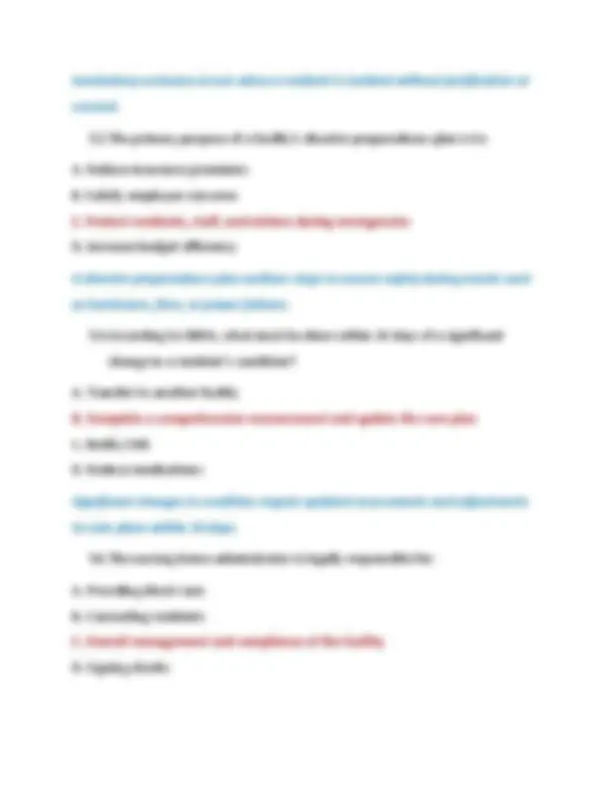
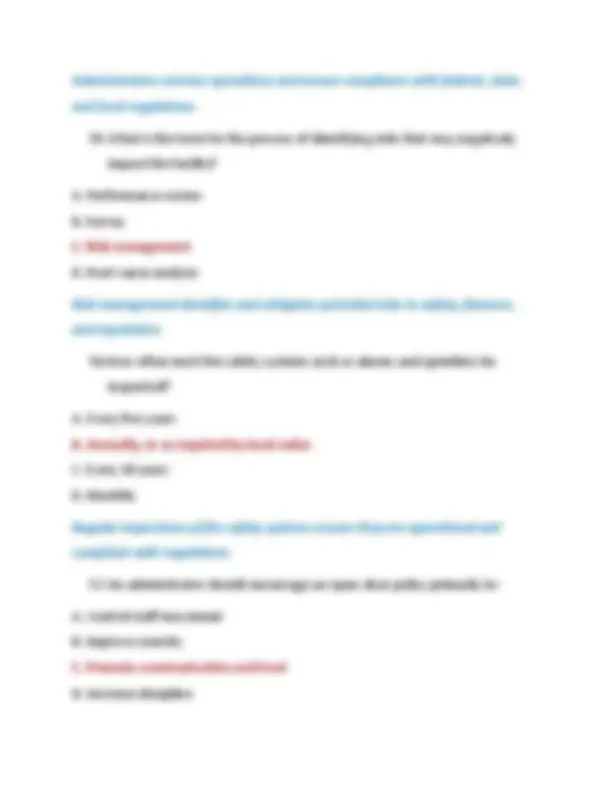
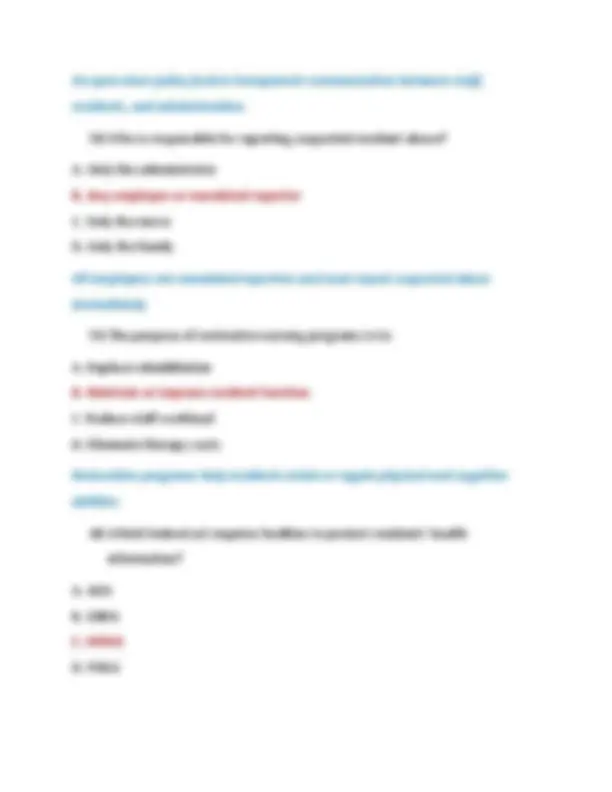
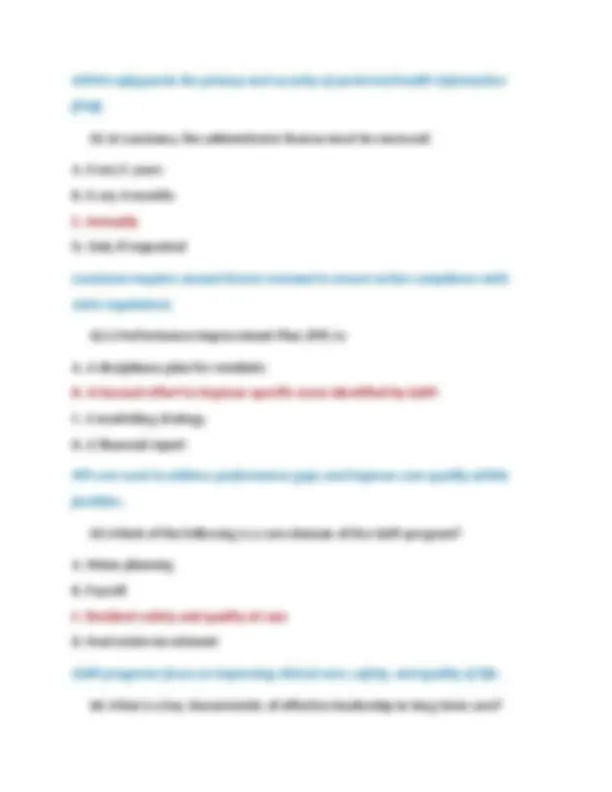
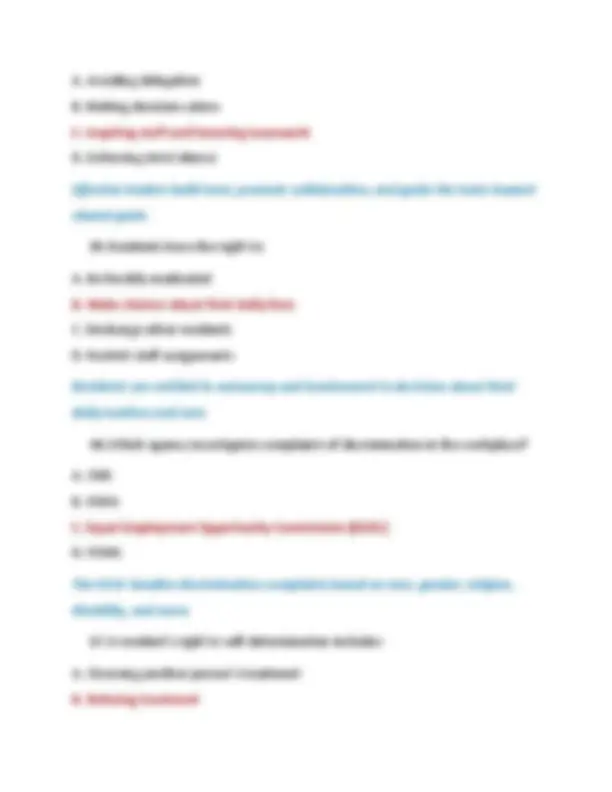
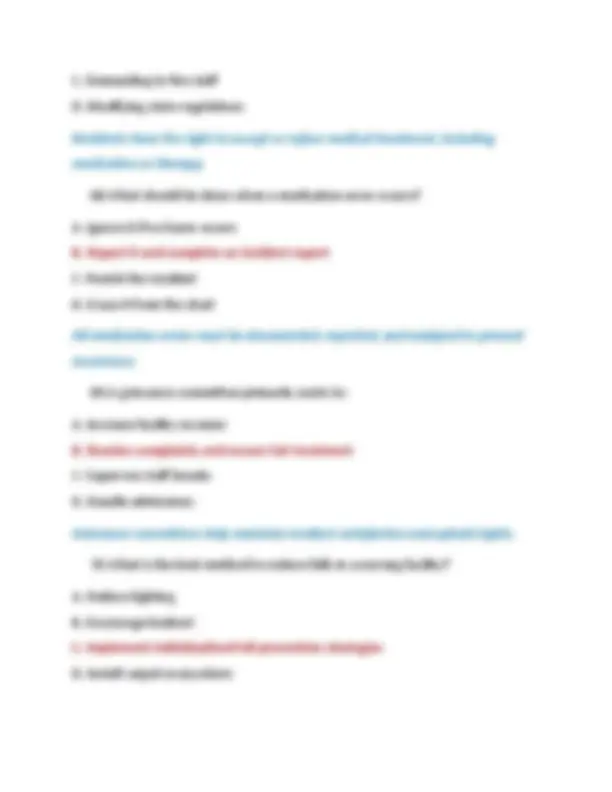
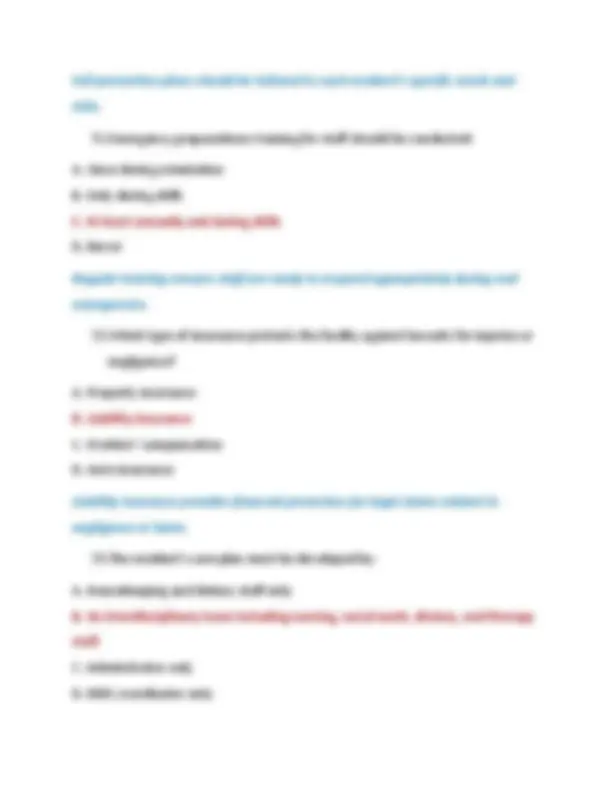
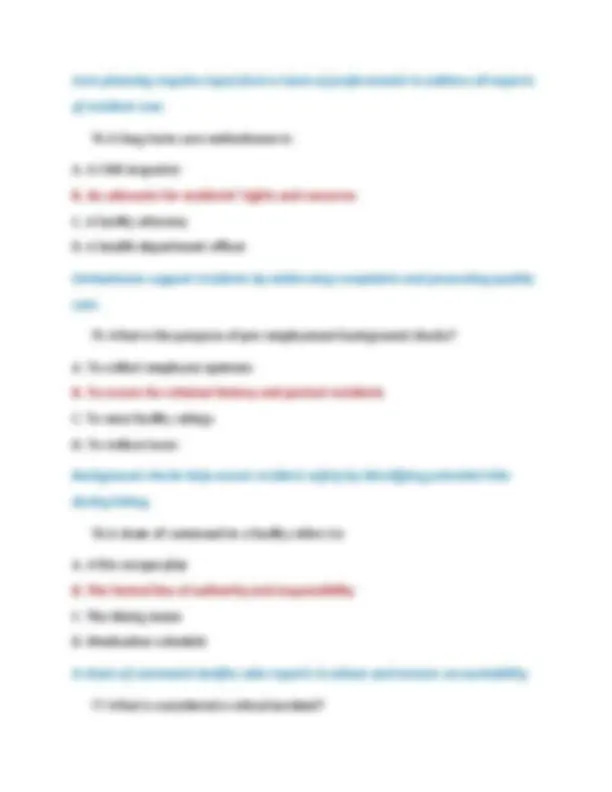
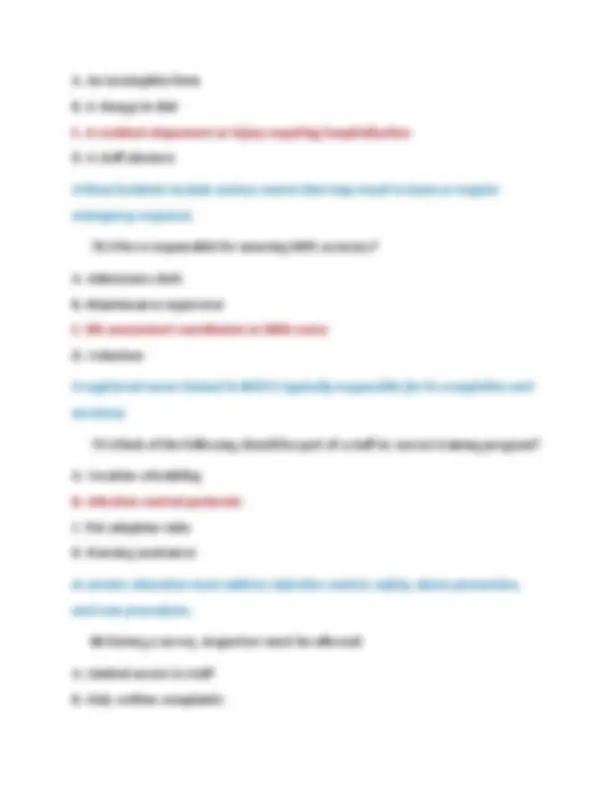
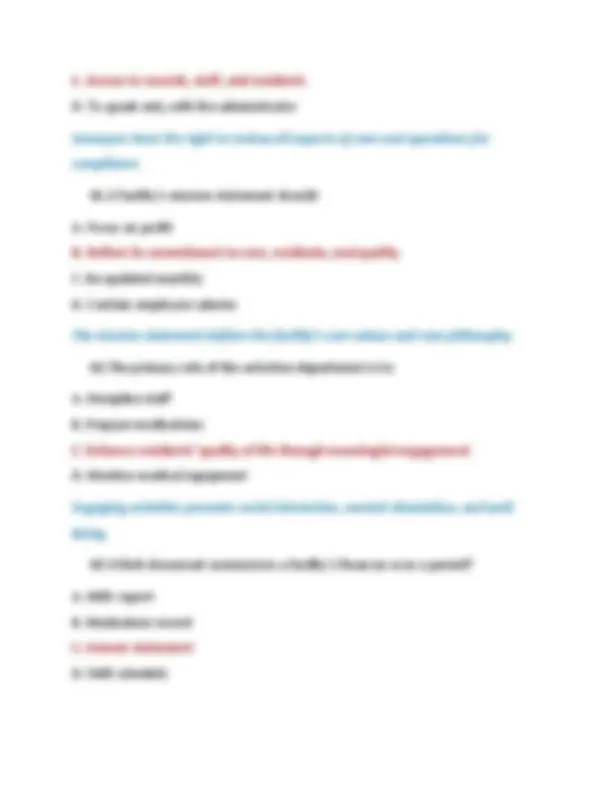
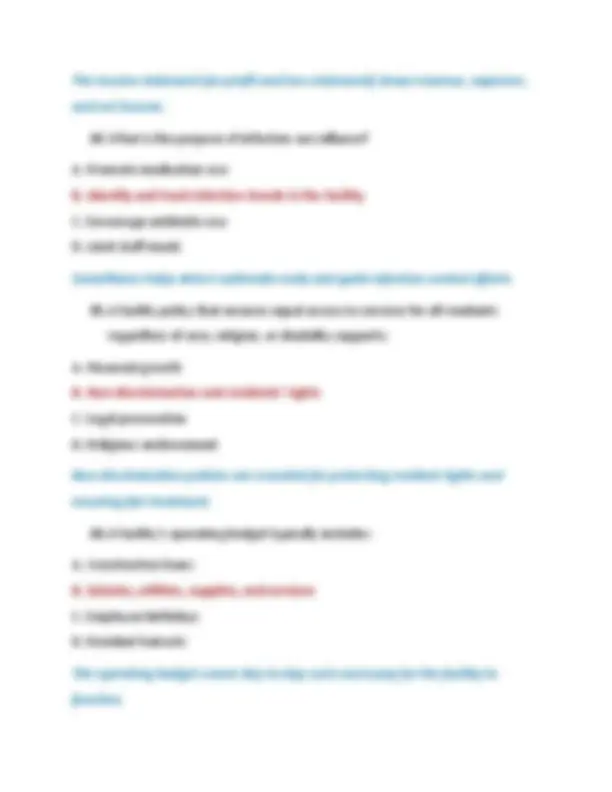
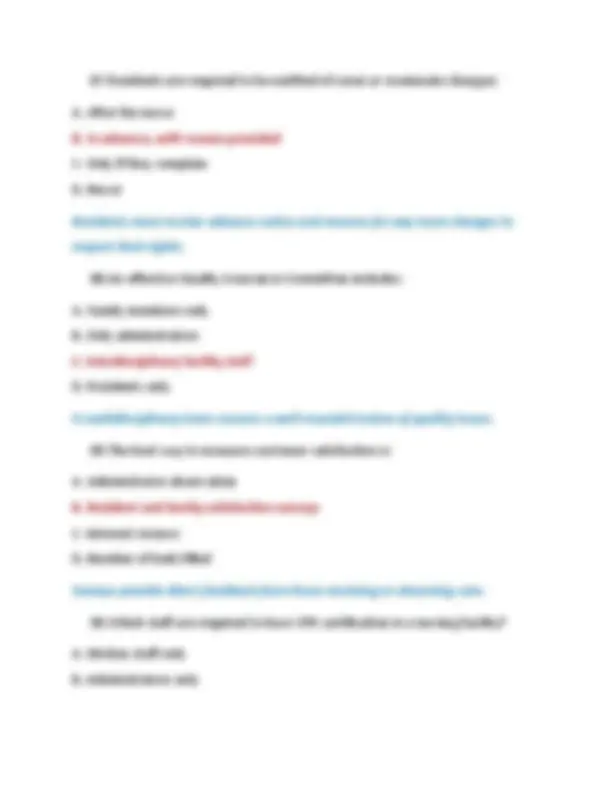
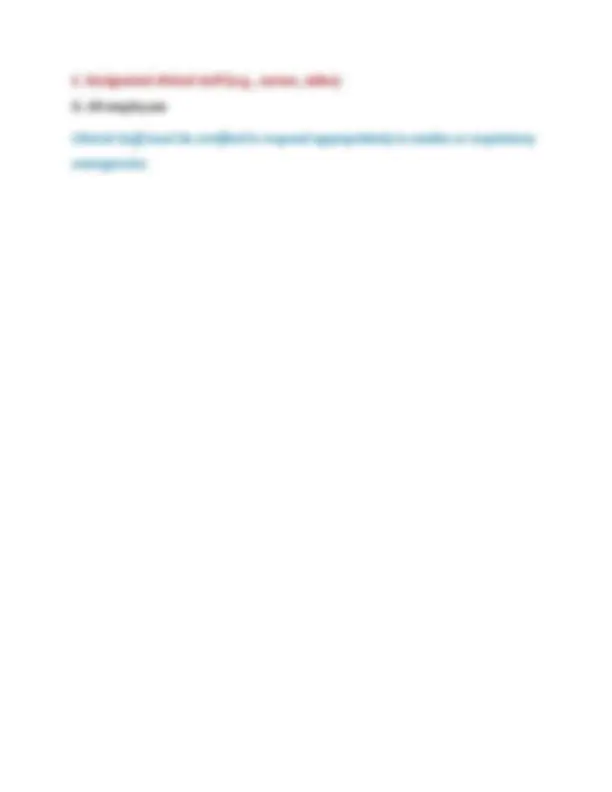


Study with the several resources on Docsity

Earn points by helping other students or get them with a premium plan


Prepare for your exams
Study with the several resources on Docsity

Earn points to download
Earn points by helping other students or get them with a premium plan
Community
Ask the community for help and clear up your study doubts
Discover the best universities in your country according to Docsity users
Free resources
Download our free guides on studying techniques, anxiety management strategies, and thesis advice from Docsity tutors
Louisiana Board of Examiners of Nursing Facility Administrators licensing exam Questions And Correct Answers (Verified Answers) Plus Rationales 2025 Q&A | Instant Download
Typology: Exams
1 / 30

This page cannot be seen from the preview
Don't miss anything!























A. Social Security Act B. Omnibus Budget Reconciliation Act (OBRA) of 1987 C. Health Insurance Portability and Accountability Act (HIPAA) D. Americans with Disabilities Act (ADA) OBRA 1987 established regulations for nursing home care, including residents' rights and care planning.
Regulations require one fire drill per shift per quarter to ensure all staff are trained under real-time conditions. 12.Which of the following best describes a “Plan of Correction” (POC) following a survey deficiency? A. A statement denying the deficiency B. A disciplinary notice to staff C. A facility's written response on how it will correct cited deficiencies D. A legal document for court use A POC outlines specific actions and timelines the facility will take to address and fix any deficiencies. 13.What is the maximum allowable time to report suspected elder abuse to appropriate authorities? A. 72 hours B. Immediately or as soon as possible C. One week D. 5 business days Timely reporting is critical, and Louisiana law mandates reporting suspected abuse as soon as possible. 14.When developing a budget for a nursing facility, which of the following is considered a capital expenditure? A. Payroll expenses B. Purchasing a new generator
C. Only upon discharge D. Biannually Residents have the right to receive quarterly statements and access their financial records upon request. 18.What is the maximum number of days allowed to complete the resident’s initial care plan after admission? A. 21 days B. 7 days C. 48 hours D. 14 days The initial care plan must be developed within 7 days after completion of the comprehensive assessment. 19.Which professional is responsible for prescribing medications in a nursing home? A. RN B. Social worker C. Licensed physician or other authorized prescriber D. Administrator Only licensed prescribers such as physicians, nurse practitioners, or PAs can prescribe medications. 20.Which of the following is a resident right under OBRA regulations? A. Right to participate in one's own care B. Right to dictate staff scheduling
C. Right to avoid bathing D. Right to fire staff directly Residents have the right to be involved in planning and making decisions about their care. 21.What is the primary purpose of the Life Safety Code (LSC)? A. To monitor employee conduct B. To prevent medication errors C. To ensure safe building design and fire protection D. To regulate water use The LSC ensures that facilities meet fire protection and safety requirements. 22.What is the function of the Resident Council in a nursing facility? A. Hire staff B. Voice concerns and provide feedback to improve care C. Approve administrator’s decisions D. Handle finances Resident Councils provide residents a platform to voice opinions, complaints, and suggestions. 23.Which of the following services must be offered but may be declined by residents? A. Immunizations B. Room cleaning C. Dietary counseling D. Medication administration
Once removed from packaging, medications should be administered immediately to prevent errors or contamination. 27.What federal agency certifies nursing homes for Medicare and Medicaid? A. OSHA B. Centers for Medicare & Medicaid Services (CMS) C. FDA D. CDC CMS is the federal body responsible for certifying facilities to receive Medicare and Medicaid funding. 28.An effective infection prevention and control program must include: A. Regular budget reviews B. Staff height and weight measurements C. Surveillance, training, and antibiotic stewardship D. Recycling policies CMS requires a comprehensive approach to prevent infections and monitor antibiotic use. 29.The term "bed hold policy" refers to: A. The facility's policy on reserving a resident’s bed during a hospital stay B. Restraining residents in bed C. Maximizing bed use D. Assigning beds based on income A bed hold policy allows a resident to return to their same bed or room after hospitalization, based on state policy.
30.What is the purpose of HIPAA in the context of nursing facilities? A. Regulate insurance premiums B. Protect resident health information C. Increase computer access D. Mandate electronic records HIPAA protects the privacy and security of patient/resident health information. 31.Which of the following is the most appropriate strategy for preventing pressure ulcers in residents? A. Provide extra blankets B. Restrict fluids C. Reposition residents regularly D. Increase medication doses Frequent repositioning helps relieve pressure on vulnerable areas, reducing the risk of pressure ulcers. 32.The facility’s infection control nurse is responsible for: A. Scheduling social activities B. Monitoring and preventing the spread of infections C. Distributing medication D. Managing kitchen staff The infection control nurse oversees protocols and interventions to limit infection spread.
36.What is the purpose of an audit trail in an electronic health record system? A. Increase internet speed B. Track who accessed or changed resident data C. Allow family access to the record D. Create new passwords Audit trails help ensure data security by logging all access and edits to patient records. 37.Which of the following is an example of a restraint? A. Bed alarms B. Lap belt used to prevent a resident from standing C. Pillows under knees D. Family encouragement to sit Any device that limits mobility and a resident’s ability to move freely is considered a restraint. 38.A facility’s safety committee should meet: A. Only after a fire drill B. Once a year C. Regularly to identify and resolve safety hazards D. Every payday Regular meetings of the safety committee ensure proactive risk management and compliance. 39.The purpose of employee orientation is to:
A. Meet state inspectors B. Familiarize staff with policies, procedures, and facility culture C. Test hiring decisions D. Promote turnover Orientation sets the foundation for compliance, performance, and staff satisfaction. 40.A facility that does not meet state regulations may be subject to: A. A pat on the back B. A donation drive C. Fines, penalties, or loss of license D. Free training Facilities that fail to comply with regulations risk enforcement actions such as monetary penalties or license suspension. 41.How long must resident medical records be retained after discharge in Louisiana? A. 1 year B. 5 years C. 3 months D. Indefinitely Louisiana requires medical records to be kept for a minimum of 5 years following discharge or death. 42.What is the goal of cultural competence in nursing homes?
C. Intentional infliction of injury or harm D. Delayed charting Abuse is any willful act that causes physical or emotional harm to a resident. 46.The main purpose of a facility policy manual is to: A. Create decorations B. Fire staff C. Guide employee actions and decisions D. Reduce state involvement A policy manual ensures consistent practices and regulatory compliance across the facility. 47.Resident assessments must be conducted by: A. Volunteers B. Kitchen staff C. Qualified licensed professionals D. Visitors Only qualified professionals (such as RNs or therapists) are authorized to perform resident assessments. 48.What is the role of the administrator in a survey process? A. Ignore it B. Call CMS directly C. Ensure compliance, coordinate responses, and lead correction efforts D. Blame staff
Administrators are responsible for overseeing the survey process and ensuring timely and effective responses. 49.A successful performance appraisal system should: A. Be punitive B. Promote professional growth and recognize accomplishments C. Be kept confidential from employees D. Be done randomly Performance appraisals support employee development and quality improvement. 50.Which federal law protects employees from discrimination based on race, sex, and religion? A. ADA B. Civil Rights Act of 1964 C. OBRA D. HIPAA The Civil Rights Act prohibits employment discrimination and promotes equal opportunities. 51.Which of the following is an example of involuntary seclusion? A. Resident chooses to stay in room B. Staff confines a resident to a room without medical reason or consent C. Resident takes a nap D. Family requests privacy for resident
Administrators oversee operations and ensure compliance with federal, state, and local regulations. 55.What is the term for the process of identifying risks that may negatively impact the facility? A. Performance review B. Survey C. Risk management D. Root cause analysis Risk management identifies and mitigates potential risks to safety, finances, and reputation. 56.How often must fire safety systems such as alarms and sprinklers be inspected? A. Every five years B. Annually, or as required by local codes C. Every 10 years D. Monthly Regular inspections of fire safety systems ensure they are operational and compliant with regulations. 57.An administrator should encourage an open-door policy primarily to: A. Control staff movement B. Improve security C. Promote communication and trust D. Increase discipline
An open-door policy fosters transparent communication between staff, residents, and administration. 58.Who is responsible for reporting suspected resident abuse? A. Only the administrator B. Any employee or mandated reporter C. Only the nurse D. Only the family All employees are mandated reporters and must report suspected abuse immediately. 59.The purpose of restorative nursing programs is to: A. Replace rehabilitation B. Maintain or improve resident function C. Reduce staff workload D. Eliminate therapy costs Restorative programs help residents retain or regain physical and cognitive abilities. 60.Which federal act requires facilities to protect residents’ health information? A. ADA B. OBRA C. HIPAA D. FMLA